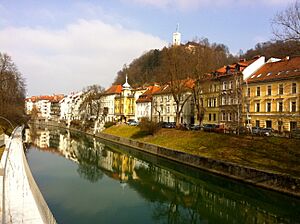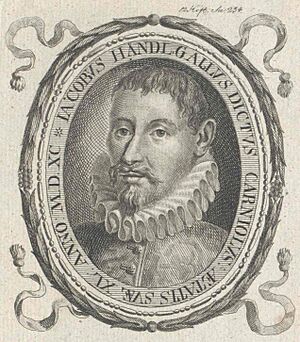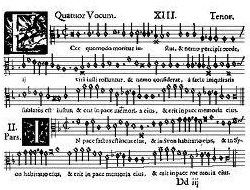Jacobus Gallus facts for kids
Jacobus Gallus (also known as Jacob Handl) was an important composer from the late Renaissance period. He was born around 1550 and died in 1591. He is thought to be of Slovene background.
Gallus was born in Carniola. This area was part of the Habsburg lands within the Holy Roman Empire back then. He spent the last ten years of his life living and working in Moravia and Bohemia.
Life of Jacobus Gallus
Gallus's name, Gallus, means 'rooster' in Latin. His German name, Handl, also means 'rooster'. In Slovenian, 'rooster' is Petelin, but Gallus never used this name himself.
He was probably born in Reifnitz, which is now called Ribnica in southern Slovenia. Some folk stories also say he was born in Šentviška Gora. Gallus always used the Latin form of his name. He often added Carniolus to show he was from Carniola.
Gallus likely studied at the Cistercian Stična Abbey in Carniola. He left Carniola between 1564 and 1566. He first traveled to Austria, then to Bohemia, Moravia, and Silesia. For a while, he lived at the Benedictine Melk Abbey in Lower Austria.
In 1574, he was part of the Viennese court chapel. From 1579 (or 1580) to 1585, he was the choirmaster (Kapellmeister) for the bishop of Olomouc. From 1585 until his death, he worked in Prague. He was an organist at the Church of St. John on the Balustrade. Gallus passed away in Prague on July 18, 1591.
Jacobus Gallus's Music
Gallus was a key figure in the Counter-Reformation in Bohemia. His music blended different styles. He mixed the complex polyphonic style of the Franco-Flemish School with the grand sound of the Venetian School.
He wrote a huge amount of music, both religious and non-religious. More than 500 of his works are known today. Some pieces were for very large groups, with multiple choirs singing up to 24 different parts at once.
His most famous work is the four-part Opus musicum (1586–1590). This is a collection of 374 motets. These motets were designed to be used throughout the entire church year. The motets were printed in Prague by Georgius Nigrinus. This printer also published 16 of his 20 known masses.
One motet, O magnum mysterium, comes from the first volume. This volume covers the period from the first Sunday of Advent to Septuagesima. His motets show the influence of the Venetian polychoral style. This style uses the coro spezzato technique, where different choirs sing separately and together.
Gallus's music had a wide and varied style. He mixed older ways of composing with newer ones. He rarely used the cantus firmus technique, which was an older method. Instead, he preferred the newer Venetian polychoral style. Yet, he was also skilled at older imitative techniques.
Some of his music used chromatic notes. These are notes outside the main scale. This hinted at changes in how music would be organized later. For example, his five-voice motet Mirabile mysterium has chromaticism similar to that of Carlo Gesualdo. Gallus also enjoyed word painting, like in a madrigal. This is where the music reflects the meaning of the words.
His non-religious music includes about 100 short pieces. These were published in collections like Harmoniae morales (Prague 1589 and 1590) and Moralia (Nuremberg 1596). Some of these were madrigals in Latin, which was unusual. Most madrigals were in Italian. Others were songs in German or other Latin compositions.
Edo Škulj has prepared modern versions of Gallus's works. These have been published by the Research Centre of the Slovenian Academy of Sciences and Arts.
Remembering Jacobus Gallus

Gallus is honored in several ways. The main hall in the Cankar Centre is called Gallus Hall. Part of the right bank of the Ljubljanica river in Ljubljana is named Gallus Embankment. This part stretches from St. James's Bridge to the Cobbler's Bridge.
The left bank of the Bistrica river in Ribnica, his birthplace, also has the same name. A monument with a bronze head of Gallus is there. It was made by architect Jože Plečnik and sculptor Lojze Dolinar in 1932. A stone plaque from 1973 also remembers him. The original plaque was put up in 1933 but was destroyed during World War II.
The Slovenian Public Fund of Cultural Activities gives out awards in his name. Deserving musicians receive Bronze, Silver, and Gold Gallus Badges and Citations every year. Gallus was also shown on the front of the 200-tolar banknote. This currency is no longer used in Slovenia.
See also
Spanish: In Spanish: Jacobus Gallus Carniolus para niños




